What to expect from the 'iPhone Fold'
Apple is expected to announce an "iPhone Fold" with a flexible OLED display by 2025. Here's what the rumor mill predicts for the device and what it may look like.
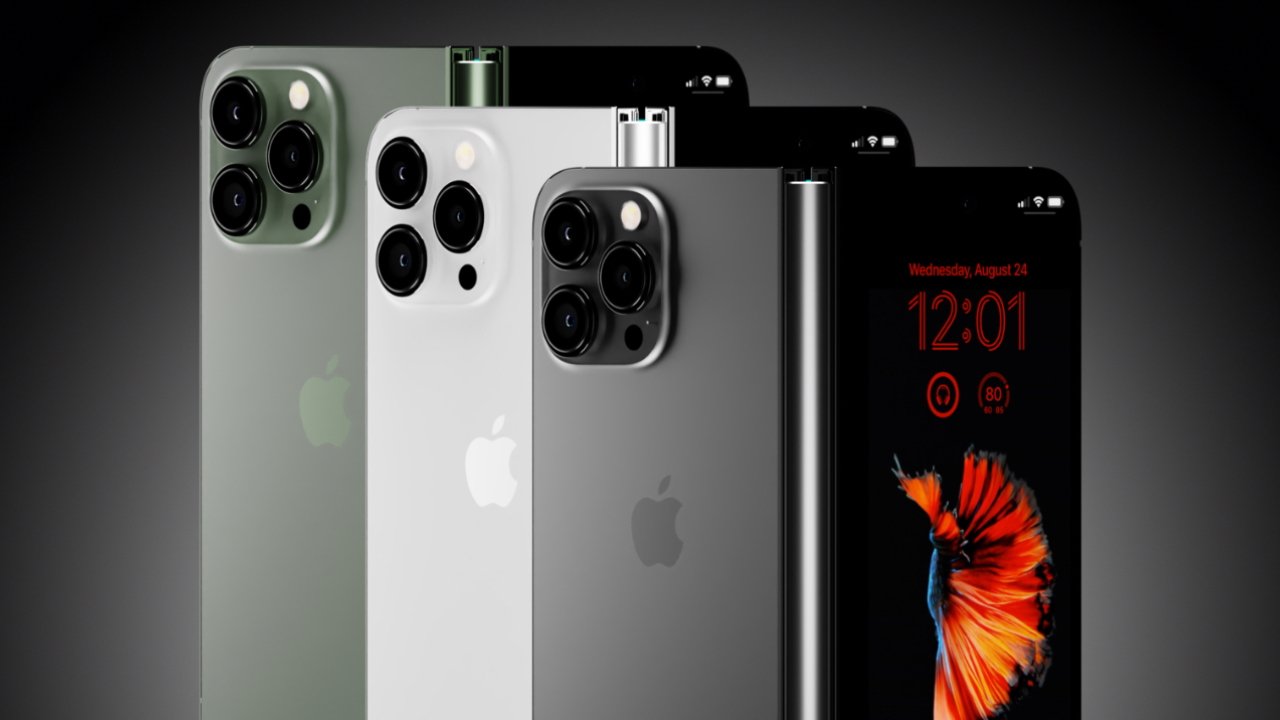
The 'iPhone Fold' is expected to take design cues from existing Apple products
Rumors and patents show that Apple has been working on a folding iPhone design for years. However, the technology required for such a device is still being developed, and it isn't clear what form the device may take.
Each year, more rumors arrive pushing the expected launch date of the "iPhone Fold" back further. In September 2021, well known analyst Ming-Chi Kuo said it may not arrive until 2024.
Later rumors from The Elec place the foldable iPhone releasing sometime in 2025. It would take the form of an iPad mini-sized product like our renders show, not a flip phone.
Unlike Apple, Samsung has been developing its folding technology in public with the Samsung Galaxy Fold and Samsung Galaxy Flip. Apple is testing both form factors for its first foldable, and rumors have been conflicting on which Apple will choose.
Even as flagship Android devices pioneer folding technology, Apple is content biding its time while the technology matures. Devices being released to the public have encountered issues from poor software optimization to creased displays.
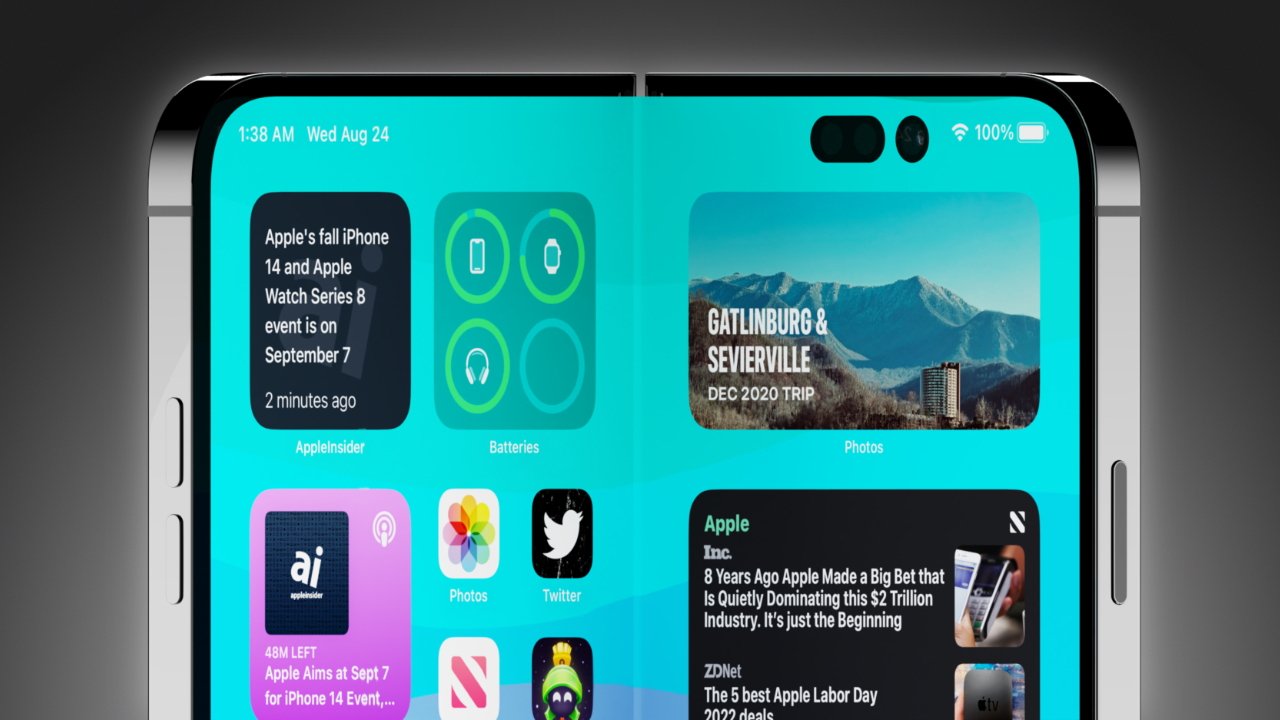
OLED is a flexible display material that can be folded without damage
Patents show that Apple expects to overcome these issues with complex hinges, new display technology, and hybrid OLED that doesn't crease. Apple isn't likely to ever release a foldable if it has such fundamental problems with the display.
Since the "iPhone 14" is expected to look similar to the iPhone 13, it seems Apple won't be introducing any radical redesign soon. We've based the renders on existing iPhone camera bumps, the rumored pill and hole punch cutout, and Apple's flat-sided industrial design.
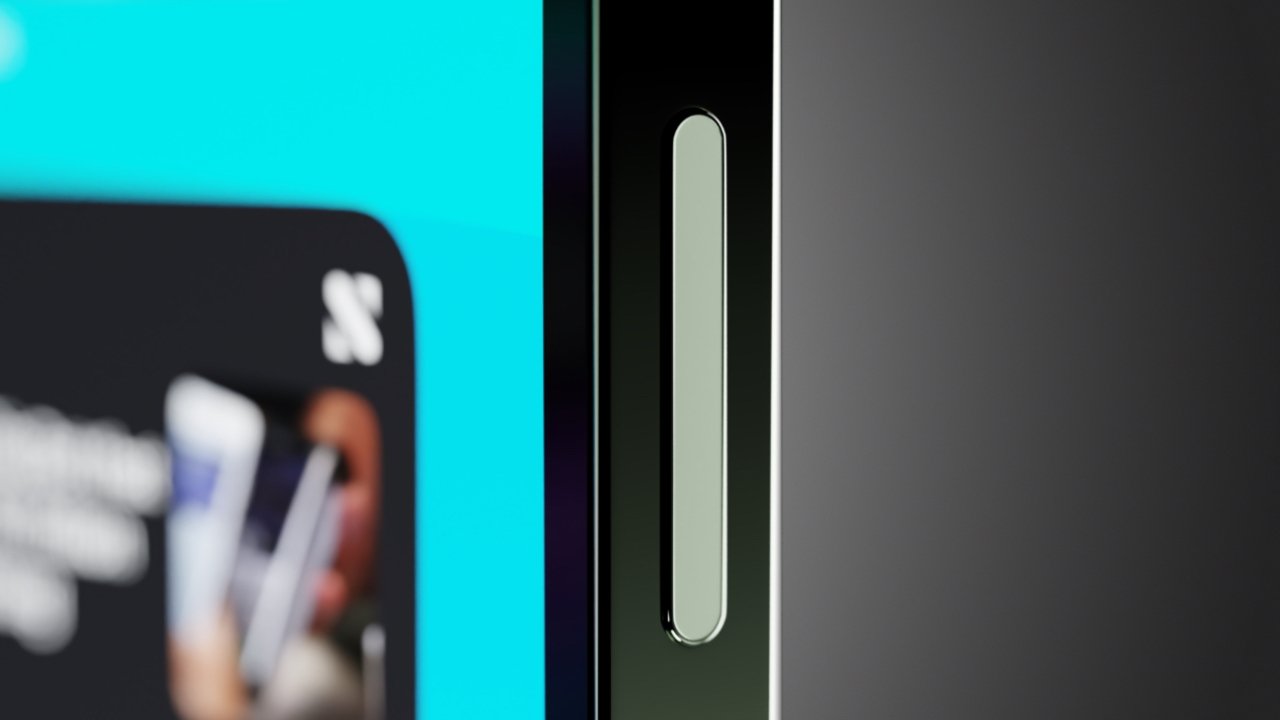
Apple could use Touch ID to simplify biometric authentication
The "iPhone Fold" would likely have a USB-C port, support MagSafe, and at the least use Touch ID. Apple could use Face ID, but placement of such a biometric sensor would be complicated on a product that can be used open or shut. We've opted to show the Face ID sensor internally, but the external power button could be used for Touch ID instead.
We expect Apple's foldable to open and close without a crease or seam in the display. Fully closed the thickness of the device should be only slightly thicker than current iPhones, while open it should be similar to the size of the iPad mini.

An external display would act as a fully functional iPhone running iOS
The external display would be thinner and taller than the usual iPhone, but it would still likely run a full version of iOS. Like Samsung's foldable, Apple will likely want the device to work like an iPhone when closed so apps can still be used normally.
It isn't yet clear how Apple will optimize iOS or iPadOS for the folding device. Little may have to change if the display only works in a fully open position. There is a chance that Apple could allow a three-quarters open or half-open mode for gaming or chat apps as well.
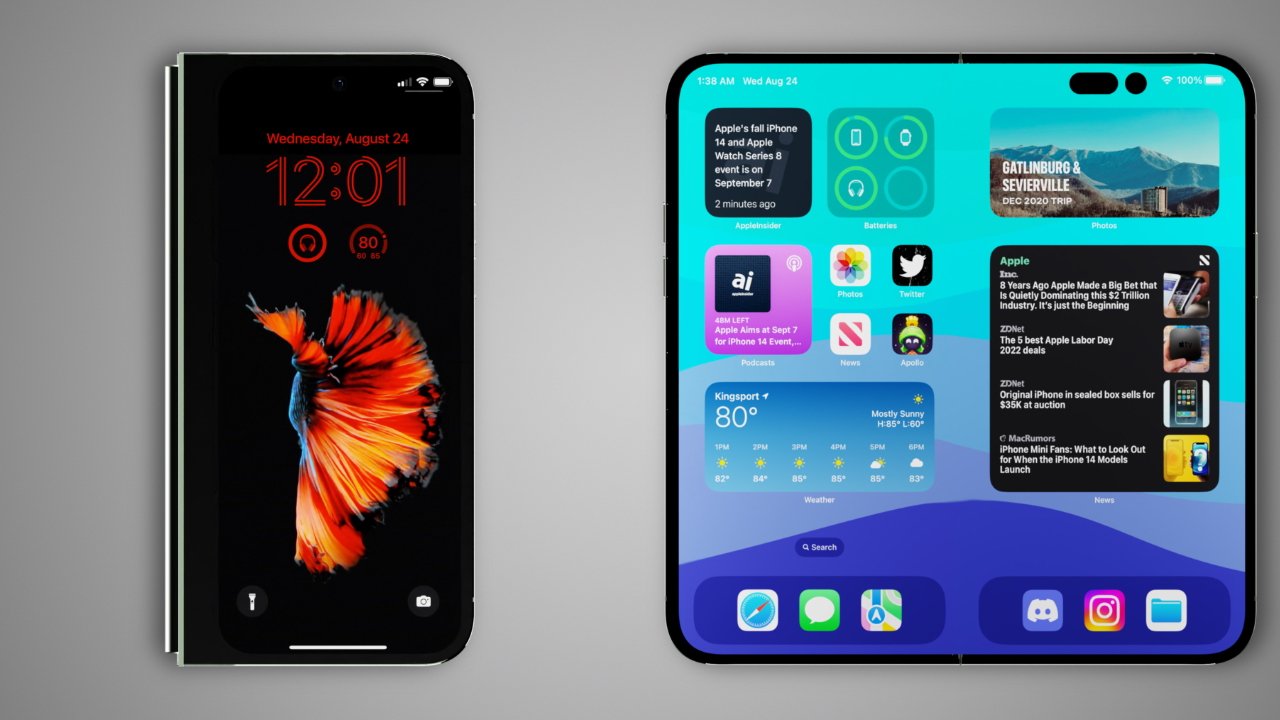
Cameras would need to be placed on both the external and internal display
Some folding Android devices have multiple positions for operation and even an external display for use when the main display is closed. While such operations would be a big departure from Apple's design philosophy, it is still possible Apple could adopt them.
For Apple's first foldable, expect it to be an iPhone or iPad that can simply fold open and shut. Beyond that, Apple may not want to sour the experience with experimental features or hardware additions.
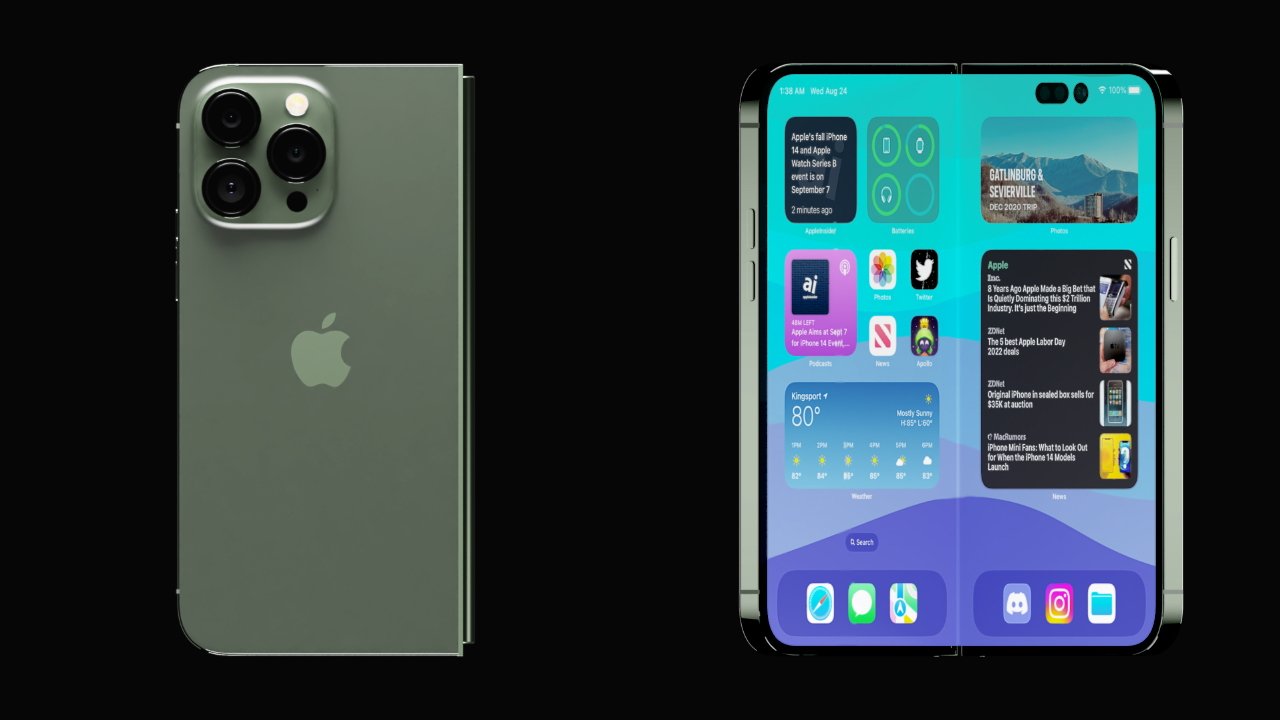
Apple is expected to announce a foldable in 2023 or later
Some users are so impatient for Apple to release a foldable that they have tried making one themselves. The product may only be demanded by a niche segment of the market, but that hasn't stopped Apple before.
The "iPhone Fold" is rumored to launch sometime in 2025 or later. There's also a chance this device will only ever exist internally at Apple and never see the light of day.
Read on AppleInsider

The 'iPhone Fold' is expected to take design cues from existing Apple products
Rumors and patents show that Apple has been working on a folding iPhone design for years. However, the technology required for such a device is still being developed, and it isn't clear what form the device may take.
Each year, more rumors arrive pushing the expected launch date of the "iPhone Fold" back further. In September 2021, well known analyst Ming-Chi Kuo said it may not arrive until 2024.
Later rumors from The Elec place the foldable iPhone releasing sometime in 2025. It would take the form of an iPad mini-sized product like our renders show, not a flip phone.
Unlike Apple, Samsung has been developing its folding technology in public with the Samsung Galaxy Fold and Samsung Galaxy Flip. Apple is testing both form factors for its first foldable, and rumors have been conflicting on which Apple will choose.
Even as flagship Android devices pioneer folding technology, Apple is content biding its time while the technology matures. Devices being released to the public have encountered issues from poor software optimization to creased displays.

OLED is a flexible display material that can be folded without damage
Patents show that Apple expects to overcome these issues with complex hinges, new display technology, and hybrid OLED that doesn't crease. Apple isn't likely to ever release a foldable if it has such fundamental problems with the display.
Since the "iPhone 14" is expected to look similar to the iPhone 13, it seems Apple won't be introducing any radical redesign soon. We've based the renders on existing iPhone camera bumps, the rumored pill and hole punch cutout, and Apple's flat-sided industrial design.

Apple could use Touch ID to simplify biometric authentication
The "iPhone Fold" would likely have a USB-C port, support MagSafe, and at the least use Touch ID. Apple could use Face ID, but placement of such a biometric sensor would be complicated on a product that can be used open or shut. We've opted to show the Face ID sensor internally, but the external power button could be used for Touch ID instead.
We expect Apple's foldable to open and close without a crease or seam in the display. Fully closed the thickness of the device should be only slightly thicker than current iPhones, while open it should be similar to the size of the iPad mini.

An external display would act as a fully functional iPhone running iOS
The external display would be thinner and taller than the usual iPhone, but it would still likely run a full version of iOS. Like Samsung's foldable, Apple will likely want the device to work like an iPhone when closed so apps can still be used normally.
It isn't yet clear how Apple will optimize iOS or iPadOS for the folding device. Little may have to change if the display only works in a fully open position. There is a chance that Apple could allow a three-quarters open or half-open mode for gaming or chat apps as well.

Cameras would need to be placed on both the external and internal display
Some folding Android devices have multiple positions for operation and even an external display for use when the main display is closed. While such operations would be a big departure from Apple's design philosophy, it is still possible Apple could adopt them.
For Apple's first foldable, expect it to be an iPhone or iPad that can simply fold open and shut. Beyond that, Apple may not want to sour the experience with experimental features or hardware additions.

Apple is expected to announce a foldable in 2023 or later
Some users are so impatient for Apple to release a foldable that they have tried making one themselves. The product may only be demanded by a niche segment of the market, but that hasn't stopped Apple before.
The "iPhone Fold" is rumored to launch sometime in 2025 or later. There's also a chance this device will only ever exist internally at Apple and never see the light of day.
Read on AppleInsider


Comments
And, personally, it's not ugly.
Coffee just sprayed out of my nose and all over my iPad keyboard.
To view the screen, id have to pull it out and now flip it open. How many more gymnastics are you wanting one handers to go through to be able to use their phones… bigger screens are hard enough. Not to mention the mechanical wear and tear on the bend and supporting structures that a static chassis does not have. I’d also be curious about how dropping the phone would/could affect the hinge.
If this comes to fruition, I guess I’ll be sticking with my 12 mini till it dies. And if it does, maybe upgrade to a 13 mini if it’s still available?
I wouldn’t mind a bigger screen, but not at the cost at my hands. Maybe I’ll accept it when there are holographic projected screens.
Those folding iPhone renders above fail to respond to really simple questions like, how do you answer a phone call on one of those things? Do you have to open it up to see who's calling and then awkwardly hold a big square to the side of your head, or is there an additional screen on the one side of the device not shown in the render? If so, that's a really expensive option requiring a lot of additional hardware, plus OS bloat to operate two screens on one device. Also, there's not a good way to put a protective case on that thing, so if there's an additional outside screen, it will be scratched and broken with great regularity. Also älso, the corners of that square hinge will be digging holes into pockets, legs and faces.
Again, what's the point of it? Wow! It the screen folds and unfolds... out into a display area not used for any particular function. Videos in every format will have to straddle the crease, unless they only use half the screen, a screen area you already have with a non-folding iPhone. The most common 16:9 video aspect ratio would only use half the screen, making it pointless, and the older 4:3 would even be letter-boxed, making the big, unfolding screen a natural for neither format.
The original iPhone itself introduced a form factor that a lot of people didn't know they needed. They may not have realized they needed it, but the utility of the thing was obvious from the start. I'd certainly looked more than once at the cellphone and Palm Pilot I was carrying around and thought it would be better if the phone disappeared and became part of the PDA. Looking at the folding iPhone renderings above, there's just isn't an obvious or even vaguely apparent utility beyond novelty that will wear off after the first few days.
Nothing. Don't expect one.
I might be alone, but i think it makes more sense to make a foldable iPad and leave the iPhone form factor alone. Its simplicity, durability, one handed use would only suffer not to mention weight etc. In a bigger device there would be more space for a folding mechanism, wouldn’t require an outer display for one handed closed operation, calls…
My main problem is the durability of any plastic screen we’ve seen so far. Until it doesn’t come close to glass or they don’t implement their self healing display to negate the disadvantages i don’t see it happen in any shape or form. Even then it introduces more and new points of failure to any device whats famed for their longevity and durability.